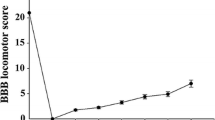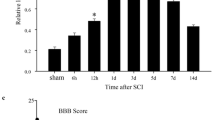Abstract
Previous studies indicated that nitric oxide (NO) is involved in secondary damage of spinal cord injury (SCI), which worsens the primary physical injury to the central nervous systems. Recently, nitric oxide synthase interacting protein (NOSIP) has been identified to interact with neuronal nitric oxide synthase (nNOS) and endothelial nitric oxide synthase by inhibiting the NO production. However, its expression and function after a central nervous system injury remains unclear. In this study, we examined the expression and cellular localization of NOSIP in the spinal cord of an adult rat. Western blot analysis indicated that NOSIP protein levels increased at day1 post-injury and peaked at day 14. Double immunofluorescence staining showed that NOSIP was primarily expressed in neurons and glial cells in the intact spinal cord. Interestingly, this study also showed that the expression of NOSIP significantly increased in astrocytes after injury. Furthermore, injury-induced expression of NOSIP was co-expressed with proliferating cell nuclear antigen (PCNA) positive astrocytes after injury. We also showed the NOSIP was co-localized with nNOS in gray matter and white matter after SCI. All these data taken together suggested that NOSIP may play an important roles in astrogliogenesis after a spinal cord injury.






Similar content being viewed by others
References
Arundine M, Tymianski M (2003) Molecular mechanisms of calcium-dependent neurodegeneration in excitotoxicity. Cell Calcium 34(4–5):325–337
Basso DM, Beattie MS, Bresnahan JC (1996) Graded histological and locomotor outcomes after spinal cord contusion using the NYU weight-drop device versus transection. Exp Neurol 139(2):244–256. doi:10.1006/exnr.1996.0098
Brahmachari S, Fung YK, Pahan K (2006) Induction of glial fibrillary acidic protein expression in astrocytes by nitric oxide. J Neurosci 26(18):4930–4939. doi:10.1523/JNEUROSCI.5480-05.2006
Carroll RC, Zukin RS (2002) NMDA-receptor trafficking and targeting: implications for synaptic transmission and plasticity. Trends Neurosci 25(11):571–577
Chen Y, Swanson RA (2003) Astrocytes and brain injury. J Cereb Blood Flow Metab 23(2):137–149
Conti A, Miscusi M, Cardali S, Germano A, Suzuki H, Cuzzocrea S, Tomasello F (2007) Nitric oxide in the injured spinal cord: synthases cross-talk, oxidative stress and inflammation. Brain Res Rev 54(1):205–218
Dedio J, Konig P, Wohlfart P, Schroeder C, Kummer W, Muller-Esterl W (2001) NOSIP, a novel modulator of endothelial nitric oxide synthase activity. FASEB J 15(1):79–89. doi:10.1096/fj.00-0078com
Diaz-Ruiz A, Ibarra A, Perez-Severiano F, Guizar-Sahagun G, Grijalva I, Rios C (2002) Constitutive and inducible nitric oxide synthase activities after spinal cord contusion in rats. Neurosci Lett 319(3):129–132
Dreyer J, Hirlinger D, Muller-Esterl W, Oess S, Kuner R (2003) Spinal upregulation of the nitric oxide synthase-interacting protein NOSIP in a rat model of inflammatory pain. Neurosci Lett 350(1):13–16
Dreyer J, Schleicher M, Tappe A, Schilling K, Kuner T, Kusumawidijaja G, Muller-Esterl W, Oess S, Kuner R (2004) Nitric oxide synthase (NOS)-interacting protein interacts with neuronal NOS and regulates its distribution and activity. J Neurosci 24(46):10454–10465. doi:10.1523/JNEUROSCI.2265-04.2004
Dumont RJ, Okonkwo DO, Verma S, Hurlbert RJ, Boulos PT, Ellegala DB, Dumont AS (2001) Acute spinal cord injury, part I: pathophysiologic mechanisms. Clin Neuropharmacol 24(5):254–264
Farooque M, Isaksson J, Olsson Y (2001) Improved recovery after spinal cord injury in neuronal nitric oxide synthase-deficient mice but not in TNF-alpha-deficient mice. J Neurotrauma 18(1):105–114. doi:10.1089/089771501750055811
Faulkner JR, Herrmann JE, Woo MJ, Tansey KE, Doan NB, Sofroniew MV (2004) Reactive astrocytes protect tissue and preserve function after spinal cord injury. J Neurosci 24(9):2143–2155. doi:10.1523/JNEUROSCI.3547-03.2004
Genovese T, Mazzon E, Mariotto S, Menegazzi M, Cardali S, Conti A, Suzuki H, Bramanti P, Cuzzocrea S (2006) Modulation of nitric oxide homeostasis in a mouse model of spinal cord injury. J Neurosurg Spine 4(2):145–153. doi:10.3171/spi.2006.4.2.145
Griffith OW, Stuehr DJ (1995) Nitric oxide synthases: properties and catalytic mechanism. Annu Rev Physiol 57:707–736. doi:10.1146/annurev.ph.57.030195.003423
Gross SS, Jaffe EA, Levi R, Kilbourn RG (1991) Cytokine-activated endothelial cells express an isotype of nitric oxide synthase which is tetrahydrobiopterin-dependent, calmodulin-independent and inhibited by arginine analogs with a rank-order of potency characteristic of activated macrophages. Biochem Biophys Res Commun 178(3):823–829
Gruner JA (1992) A monitored contusion model of spinal cord injury in the rat. J Neurotrauma 9(2): 123–126; discussion 126–128
Hamada Y, Ikata T, Katoh S, Tsuchiya K, Niwa M, Tsutsumishita Y, Fukuzawa K (1996) Roles of nitric oxide in compression injury of rat spinal cord. Free Radic Biol Med 20(1):1–9
Huan W, Wu X, Zhang S, Zhao Y, Xu H, Wang N, Li H, Chen H, Wei H, Wang Y (2012) Spatiotemporal patterns and essential role of TNF receptor-associated factor 5 expression after rat spinal cord Injury. J Mol Histol. doi:10.1007/s10735-012-9411-5
Keane RW, Davis AR, Dietrich WD (2006) Inflammatory and apoptotic signaling after spinal cord injury. J Neurotrauma 23(3–4):335–344. doi:10.1089/neu.2006.23.335
Knowles RG, Palacios M, Palmer RM, Moncada S (1990) Kinetic characteristics of nitric oxide synthase from rat brain. Biochem J 269(1):207–210
Konig P, Dedio J, Muller-Esterl W, Kummer W (2002) Distribution of the novel eNOS-interacting protein NOSIP in the liver, pancreas, and gastrointestinal tract of the rat. Gastroenterology 123(1):314–324
Konig P, Dedio J, Oess S, Papadakis T, Fischer A, Muller-Esterl W, Kummer W (2005) NOSIP and its interacting protein, eNOS, in the rat trachea and lung. J Histochem Cytochem 53(2):155–164. doi:10.1369/jhc.4A6453.2005
Kwon BK, Tetzlaff W, Grauer JN, Beiner J, Vaccaro AR (2004) Pathophysiology and pharmacologic treatment of acute spinal cord injury. Spine J 4(4):451–464. doi:10.1016/j.spinee.2003.07.007
Li N, Sul JY, Haydon PG (2003) A calcium-induced calcium influx factor, nitric oxide, modulates the refilling of calcium stores in astrocytes. J Neurosci 23(32):10302–10310
Lu J, Ashwell KW, Waite P (2000) Advances in secondary spinal cord injury: role of apoptosis. Spine (Phila Pa 1976) 25(14): 1859–1866
Matsuyama Y, Sato K, Kamiya M, Yano J, Iwata H, Isobe K (1998) Nitric oxide: a possible etiologic factor in spinal cord cavitation. J Spinal Discord 11(3):248–252
Morganti-Kossmann MC, Rancan M, Stahel PF, Kossmann T (2002) Inflammatory response in acute traumatic brain injury: a double-edged sword. Curr Opin Crit Care 8(2):101–105
Mrak RE, Griffin WS (2005) Glia and their cytokines in progression of neurodegeneration. Neurobiol Aging 26(3):349–354. doi:10.1016/j.neurobiolaging.2004.05.010
Murphy S (2000) Production of nitric oxide by glial cells: regulation and potential roles in the CNS. Glia 29(1):1–13. doi:10.1002/(SICI)1098-1136(20000101)29:1<1:AID-GLIA1>3.0.CO;2-N
Murphy S, Simmons ML, Agullo L, Garcia A, Feinstein DL, Galea E, Reis DJ, Minc-Golomb D, Schwartz JP (1993) Synthesis of nitric oxide in CNS glial cells. Trends Neurosci 16(8):323–328
Nozaki K, Moskowitz MA, Maynard KI, Koketsu N, Dawson TM, Bredt DS, Snyder SH (1993) Possible origins and distribution of immunoreactive nitric oxide synthase-containing nerve fibers in cerebral arteries. J Cereb Blood Flow Metab 13(1):70–79. doi:10.1038/jcbfm.1993.9
Osuka K, Watanabe Y, Takagi T, Usuda N, Atsuzawa K, Yoshida J, Takayasu M (2008) Activation of endothelial nitric oxide synthase following spinal cord injury in mice. Neurosci Lett 436(2):265–268. doi:10.1016/j.neulet.2008.03.039
Park E, Velumian AA, Fehlings MG (2004) The role of excitotoxicity in secondary mechanisms of spinal cord injury: a review with an emphasis on the implications for white matter degeneration. J Neurotrauma 21(6):754–774. doi:10.1089/0897715041269641
Rameau GA, Chiu LY, Ziff EB (2004) Bidirectional regulation of neuronal nitric-oxide synthase phosphorylation at serine 847 by the N-methyl-D-aspartate receptor. J Biol Chem 279(14):14307–14314. doi:10.1074/jbc.M311103200
Schleicher M, Brundin F, Gross S, Muller-Esterl W, Oess S (2005) Cell cycle-regulated inactivation of endothelial NO synthase through NOSIP-dependent targeting to the cytoskeleton. Mol Cell Biol 25(18):8251–8258. doi:10.1128/MCB.25.18.8251-8258.2005
Sharma HS, Nyberg F, Gordh T, Alm P (2006) Topical application of dynorphin A (1–17) antibodies attenuates neuronal nitric oxide synthase up-regulation, edema formation, and cell injury following focal trauma to the rat spinal cord. Acta Neurochir Suppl 96:309–315
Silver J, Miller JH (2004) Regeneration beyond the glial scar. Nat Rev Neurosci 5(2):146–156. doi:10.1038/nrn1326
Sofroniew MV (2009) Molecular dissection of reactive astro gliosis and glial scar formation. Trends Neurosci 32(12):638–647. doi:10.1016/j.tins.2009.08.002
Somera-Molina KC, Robin B, Somera CA, Anderson C, Stine C, Koh S, Behanna HA, Van Eldik LJ, Watterson DM, Wainwright MS (2007) Glial activation links early-life seizures and long-term neurologic dysfunction: evidence using a small molecule inhibitor of proinflammatory cytokine upregulation. Epilepsia 48(9):1785–1800. doi:10.1111/j.1528-1167.2007.01135.x
Zai LJ, Wrathall JR (2005) Cell proliferation and replacement following contusive spinal cord injury. Glia 50(3):247–257. doi:10.1002/glia.20176
Zhu Z, Kremer P, Tadmori I, Ren Y, Sun D, He X, Young W (2011) Lithium suppresses astrogliogenesis by neural stem and progenitor cells by inhibiting STAT3 pathway independently of glycogen synthase kinase 3 beta. PLoS ONE 6(9):e23341. doi:10.1371/journal.pone.0023341
Acknowledgments
This work was supported by the National Natural Science Foundation of China (No. 81071487, No. 31070723, and No. 31270802); Natural Science Foundation of Jiangsu Province, China (No. BK2009449); Social Development Program of Jiangsu Province, China (No. BE2010744); and Medical Scientific Research Foundation of Jiangsu Province, China (No. H201008).
Author information
Authors and Affiliations
Corresponding authors
Additional information
Xiaowei Yu and Yi Zhong contributed equally to this work.
Rights and permissions
About this article
Cite this article
Yu, X., Zhong, Y., Zhu, Z. et al. Increased expression of nitric oxide synthase interacting protein (NOSIP) following traumatic spinal cord injury in rats. J Mol Hist 43, 661–668 (2012). https://doi.org/10.1007/s10735-012-9460-9
Received:
Accepted:
Published:
Issue Date:
DOI: https://doi.org/10.1007/s10735-012-9460-9




